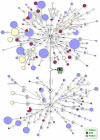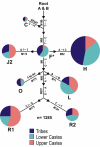Genetic affinities among the lower castes and tribal groups of India: inference from Y chromosome and mitochondrial DNA - PubMed (original) (raw)
Genetic affinities among the lower castes and tribal groups of India: inference from Y chromosome and mitochondrial DNA
Ismail Thanseem et al. BMC Genet. 2006.
Abstract
Background: India is a country with enormous social and cultural diversity due to its positioning on the crossroads of many historic and pre-historic human migrations. The hierarchical caste system in the Hindu society dominates the social structure of the Indian populations. The origin of the caste system in India is a matter of debate with many linguists and anthropologists suggesting that it began with the arrival of Indo-European speakers from Central Asia about 3500 years ago. Previous genetic studies based on Indian populations failed to achieve a consensus in this regard. We analysed the Y-chromosome and mitochondrial DNA of three tribal populations of southern India, compared the results with available data from the Indian subcontinent and tried to reconstruct the evolutionary history of Indian caste and tribal populations.
Results: No significant difference was observed in the mitochondrial DNA between Indian tribal and caste populations, except for the presence of a higher frequency of west Eurasian-specific haplogroups in the higher castes, mostly in the north western part of India. On the other hand, the study of the Indian Y lineages revealed distinct distribution patterns among caste and tribal populations. The paternal lineages of Indian lower castes showed significantly closer affinity to the tribal populations than to the upper castes. The frequencies of deep-rooted Y haplogroups such as M89, M52, and M95 were higher in the lower castes and tribes, compared to the upper castes.
Conclusion: The present study suggests that the vast majority (> 98%) of the Indian maternal gene pool, consisting of Indio-European and Dravidian speakers, is genetically more or less uniform. Invasions after the late Pleistocene settlement might have been mostly male-mediated. However, Y-SNP data provides compelling genetic evidence for a tribal origin of the lower caste populations in the subcontinent. Lower caste groups might have originated with the hierarchical divisions that arose within the tribal groups with the spread of Neolithic agriculturalists, much earlier than the arrival of Aryan speakers. The Indo-Europeans established themselves as upper castes among this already developed caste-like class structure within the tribes.
Figures
Figure 1
A network relating Pardhan, Naikpod and Andh haplotypes. Circle areas are proportional to the haplotype frequencies. Variant bases are numbered and shown along the links between haplotypes. Character change is specified only for transversions. Mutations in the HVR I region are only mentioned except that defines haplogroups. Variations at hyper-variable positions 16182, 16183 and 16517 are not shown
Figure 2
Y chromosomal haplogroups and their frequencies (%)in three South Indian tribal populations. Haplogroup defining markers and their background average variance of 6 STR loci are shown along the branches of the tree.
Figure 3
Distribution of major Y-SNP haplogroups among the tribal, lower caste and upper caste populations of India.
Similar articles
- Genetic evidence on the origins of Indian caste populations.
Bamshad M, Kivisild T, Watkins WS, Dixon ME, Ricker CE, Rao BB, Naidu JM, Prasad BV, Reddy PG, Rasanayagam A, Papiha SS, Villems R, Redd AJ, Hammer MF, Nguyen SV, Carroll ML, Batzer MA, Jorde LB. Bamshad M, et al. Genome Res. 2001 Jun;11(6):994-1004. doi: 10.1101/gr.gr-1733rr. Genome Res. 2001. PMID: 11381027 Free PMC article. - The genetic heritage of the earliest settlers persists both in Indian tribal and caste populations.
Kivisild T, Rootsi S, Metspalu M, Mastana S, Kaldma K, Parik J, Metspalu E, Adojaan M, Tolk HV, Stepanov V, Gölge M, Usanga E, Papiha SS, Cinnioğlu C, King R, Cavalli-Sforza L, Underhill PA, Villems R. Kivisild T, et al. Am J Hum Genet. 2003 Feb;72(2):313-32. doi: 10.1086/346068. Epub 2003 Jan 20. Am J Hum Genet. 2003. PMID: 12536373 Free PMC article. - Independent origins of Indian caste and tribal paternal lineages.
Cordaux R, Aunger R, Bentley G, Nasidze I, Sirajuddin SM, Stoneking M. Cordaux R, et al. Curr Biol. 2004 Feb 3;14(3):231-5. doi: 10.1016/j.cub.2004.01.024. Curr Biol. 2004. PMID: 14761656 - Y Chromosome Story-Ancient Genetic Data as a Supplementary Tool for the Analysis of Modern Croatian Genetic Pool.
Primorac D, Šarac J, Havaš Auguštin D, Novokmet N, Bego T, Pinhasi R, Šlaus M, Novak M, Marjanović D. Primorac D, et al. Genes (Basel). 2024 Jun 6;15(6):748. doi: 10.3390/genes15060748. Genes (Basel). 2024. PMID: 38927684 Free PMC article. Review. - Prevalence of diabetes mellitus in Indian tribal population: a systematic review and meta-analysis.
Hazarika CR, Babu BV. Hazarika CR, et al. Ethn Health. 2023 May;28(4):544-561. doi: 10.1080/13557858.2022.2067836. Epub 2022 Apr 25. Ethn Health. 2023. PMID: 35469488 Review.
Cited by
- The maternal U1 haplogroup in the Koraga tribe as a correlate of their North Dravidian linguistic affinity.
Sequeira JJ, Vinuthalakshmi K, Das R, van Driem G, Mustak MS. Sequeira JJ, et al. Front Genet. 2024 Feb 7;14:1303628. doi: 10.3389/fgene.2023.1303628. eCollection 2023. Front Genet. 2024. PMID: 38384360 Free PMC article. - Contrasting maternal and paternal genetic histories among five ethnic groups from Khyber Pakhtunkhwa, Pakistan.
Tariq M, Ahmad H, Hemphill BE, Farooq U, Schurr TG. Tariq M, et al. Sci Rep. 2022 Jan 19;12(1):1027. doi: 10.1038/s41598-022-05076-3. Sci Rep. 2022. PMID: 35046511 Free PMC article. - Genomics of rare genetic diseases-experiences from India.
GUaRDIAN Consortium; Sivasubbu S, Scaria V. GUaRDIAN Consortium, et al. Hum Genomics. 2019 Sep 25;14(1):52. doi: 10.1186/s40246-019-0215-5. Hum Genomics. 2019. PMID: 31554517 Free PMC article. Review. - The peopling of Lakshadweep Archipelago.
Mustak MS, Rai N, Naveen MR, Prakash S, Carlus SJ, Pasupuleti N, Srivastava A, Singh PP, Babu I, Dubey PK, Chaubey G, Thangaraj K. Mustak MS, et al. Sci Rep. 2019 May 6;9(1):6968. doi: 10.1038/s41598-019-43384-3. Sci Rep. 2019. PMID: 31061397 Free PMC article. - A comprehensive portrait of Y-STR diversity of Indian populations and comparison with 129 worldwide populations.
Singh M, Sarkar A, Nandineni MR. Singh M, et al. Sci Rep. 2018 Oct 18;8(1):15421. doi: 10.1038/s41598-018-33714-2. Sci Rep. 2018. PMID: 30337554 Free PMC article. Clinical Trial.
References
- Ratnagar S. Archaeological perspectives of early Indian societies. In: Thapar R, editor. Recent perspectives of early Indian history. Mumbai, India: Popular Prakashan; 1995. pp. 1–52.
- Bamshad M, Kivisild T, Watkins WS, Dixon ME, Ricker CE, Rao BB, Naidu JM, Prasad BVR, Reddy PG, Rasanayagam A, Papiha SS, Villems R, Redd AJ, Hammer MF, Nguyen SV, Carroll ML, Batzer MA, Jorde LB. Genetic evidence on the origins of Indian caste populations. Genome Res. 2001;11:994–1004. doi: 10.1101/gr.GR-1733RR. - DOI - PMC - PubMed
- Kivisild T, Rootsi S, Metspalu M, Mastana S, Kaldma K, Parik J, Metspalu E, Adojaan M, Tolk H-V, Stepanov V, Gölge M, Usanga E, Papiha SS, Cinnioglu C, King R, Cavalli-Sforza L, Underhill PA, Villems R. The genetic heritage of earliest settlers persist in both the Indian tribal and caste populations. Am J Hum Genet. 2003;72:313–332. doi: 10.1086/346068. - DOI - PMC - PubMed
Publication types
MeSH terms
Substances
LinkOut - more resources
Full Text Sources
Research Materials


